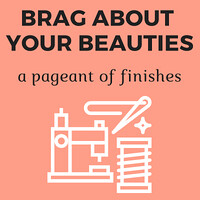At times I feel trapped in a world of 45-degree angles. It’s how I prefer to sew, though: no curves, no templates, no foundation piecing. Still, the 45-degree angle has its limitations. Perhaps that’s why I had so much fun indulging in a little raw-edge applique this week: So many different shapes are possible with applique!
I don’t have much experience with any particular applique technique. I’ve never tried needle-turn applique, mainly because I dislike handwork. I did experiment with reverse applique, which is really a different beast altogether and isn’t something you can just add at the end of a project, when I made a project about my son with Down syndrome (check out the quilt and my parenting story here).
A few summers ago, though, I followed a pattern from Ameroonie Designs and appliqued the sweetest strawberries for my guild’s mug rug swap. The small pieces made for some fiddly cutting, but everything came out great and, in the end, it was hard to pass this beauty on to a guildmate.
Recently after binding a project, I decided it needed a little something extra. It was time to applique again.
I found some HeatnBond in my stash and played around with scraps. (See my prototype at the top of the post.) I drew a heart on regular paper and traced the shape to the paper side of the HeatnBond. Then, using an iron, I adhered the heart to the wrong side of my fabric and cut out the shape. Next, I peeled off the paper backing, ironed the heart onto my scrap quilt sandwich, and stitched along the edges of the shape three times with a mess-on-purpose approach. I really love the look of the imperfect lines, and satisfied with the results, I repeated the process with my actual project.
I suppose I could have appliqued before I had the quilt top longarmed, but I like how the hearts are unbroken by the quilting lines—adding them afterward really makes them pop.
The quilt top isn’t ready for public consumption yet, so you’ll have to trust me that those red hearts make all the difference. The rest of the quilt is gray, cream, and so very blue. The hearts, with their nice curves and bold color, give viewers a much-needed spot to focus on.
I am no applique expert, as evidenced by the fact that I repeatedly tried to iron on the cut-out shapes without removing their paper backing first, but I am sure some of you are. I’d love to hear your take on raw-edge applique in particular ... How does your approach differ from mine? How do you think it holds up in the wash? Let me know in the comments!
Follow Me On ...
The pageant rules are simple:
- Post your finish in the linky tool. (No links to your own giveaway or linky, please!)
- Point your readers back here with a text link or use the button above.
- Visit and comment on other participants’ finishes.







Cute, Michelle!!! I recognize the pattern and style! I've done this type of Heat N Bond + 3 times stitching around appliqué, also, but always on wall hangings that won't get washed, so I can't comment on the washability. With the triple stitching and glue, I would think it would hold up. Looking forward to the reveal!!!
ReplyDeleteAwww, those are so cute! I don't do much appliqué either. In fact, I actively avoid it. 😄
ReplyDeleteLooks like you found the perfect finishing touch for that quilt! I haven't done a ton of applique one way or the other, either, but I did learn the "crafted applique" method for raw edges that helps keep the fabric from fraying. It was a book written many years ago now, and so if you want to decrease fray, you might want to look for that.
ReplyDeleteNo aplique-er either ... but I love the look of your red hearts and am very sure they are an additional highlight on the quilt. xo
ReplyDeleteNo finish to share, but I'll comment about appliqué. You're on the right track to give it a go, as you are. And what you did with the strawberries looks great. I love hand appliqué though I rarely do it because it's not very modern. These days my favorite shape to hand appliqué is a circle. Though I always appliqué circles with the needle turn method, my overall favorite appliqué method is back-basted. That's where you stitch on the stitching line on the back of the appliqué and through the appliqué with a thick thread, like quilting thread. Then you pull out basting threads as you stitch the appliqué into position. As for raw edge appliqué, I use that method only on quilts (usually a wallhanging) I don't intend to wash. I just don't care for the frayed look that usually happens after washing.
ReplyDelete